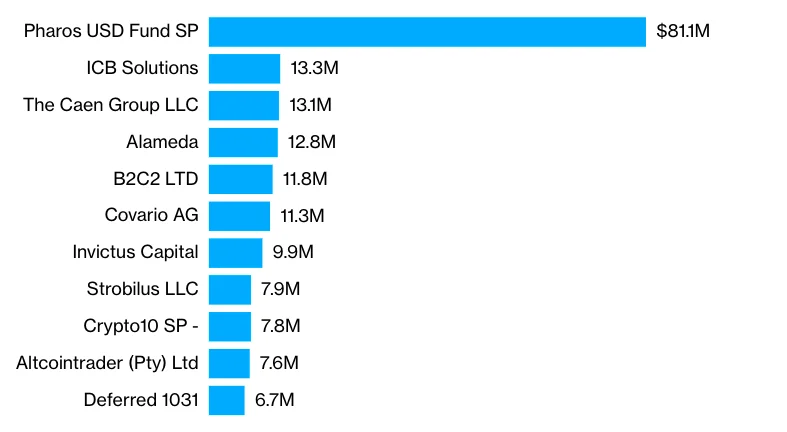The inner workings of Celsius. What led to the collapse of one of the largest cryptocurrency lenders
How the pursuit of quick profits and fraudulent schemes turned into bankruptcy

22.07.2022
1745
7 min
0
On June 13, crypto lending platform Celsius suspended withdrawals and transfers due to tough market conditions, and a month later filed for bankruptcy. In the community, the situation has been called crypto’s “Lehman Brothers moment,” named after the investment firm that just as unexpectedly collapsed in 2008, triggering the global crisis. As in the case of Celsius, many factors led to it, including the situation inside the company. Let's find out what was going on behind the scenes at Celsius and how Sam Bankman-Fried, head of the FTX exchange, was involved.
Celsius' bankruptcy
The first alarms for the platform began before the global crypto winter, when rising interest rates prompted investors to liquidate potentially risky assets. As early as May, when the Terra ecosystem collapsed, the Celsius economy finally crashed. At its core, the platform relied only on money from retail investors, which it subsequently lent to other cryptocurrency companies and used for ill-considered investments.
At the first bankruptcy hearing, Celsius' lawyers said that most of the client funds on the platform were at the full disposal of the company. Attorneys cited the company's terms and conditions, which state that 77% of the assets were pledged under an “earnings program.” That means that, according to the platform's rules, Celsius can use them however it wants.
The company accumulated about $20 billion in deposit accounts. This is not surprising, since the platform offered interest rates of up to 18% per annum on cryptocurrency deposits. The head of the company, Alex Mashinsky, has always personally stated that Celsius' investment schemes are sound and reliable. “We are actually safer than most banks,” he said in an interview in 2020.
Before filing for bankruptcy, the company managed to pay off its creditors represented by DeFi-Protocols Maker, Aave, and Compound. In total, Celsius recovered $1 billion in collateral. The filing itself involves a financial restructuring. Celsius said it had $167 million left in its accounts, which would be used to maintain liquidity.
At this point, the scandals surrounding the lending protocol were not about to subside. In early July, Jason Stone, one of Celsius' former asset managers, sued the company. According to the accusation, Celsius used its clients' funds uncontrollably in risky trading strategies, resulting in the loss of a huge amount of money. In the lawsuit, Stone also pointed to the platform's inability to make payments to investors and noted “severe exchange rate losses.”
Semi-legal schemes and shadow documentation
Financial Times reporters examined Celsius' documents and reports and found many inconsistencies. Even the company's supervisory department pointed to flaws in internal accounting systems and misrepresentation of financial statements. Also, documents requested by the US Securities and Exchange Commission (SEC) said that several Celsius co-founders, including Daniel Leon, sold personal stocks of the CEL platform's native token directly to the company several times.
This is just one of the strange token manipulations seen at Celsius. A particular component of the company's business model was that it only offered the highest rates to customers who agreed to receive payments in CEL token. Given that Celsius owned most of its own asset, it essentially had complete control over the price of the token. Prior to the funds freeze, the company bought back a certain percentage of CEL on a weekly basis to maintain its balance. According to Arkham Intelligence, Celsius has spent $350 million buying its own token since July 2019.
Managers took advantage of CEL's rising price for their own purposes. On the same day that Leon published a video in which he talked about the cryptocurrency's bright future, Celsius transaction records list the sale of Leon's personal CEL tokens to the company for $1,8 million. Sixteen such transactions were found to have taken place between October 2020 and August 2021. According to the documents, the total amount of such transactions is estimated at $11,4 million. Other Celsius managers sold $40 million worth of CEL tokens during the same period.
CEO Alex Mashinsky made only one such transaction for $500 000. Some employees interviewed, however, believe he may have made transactions through other accounts and addresses. Based on blockchain records, Arkham analysts estimated that Mashinsky sold $44 million worth of CEL through exchanges.
According to internal documents, the company began investing in DeFi-services in 2020 without proper diligence on projects or proper systems to track assets. Last February, the internal oversight department sent a warning that some employees may have invested money in new funds without explicit permission or compliance checks. The document also said brokers could move assets from one fund to another unnoticed by management, allowing them to hide losses and the real value of assets under management.
How Celsius lost its customers' hundreds of millions of dollars on high-risk schemes
According to former employees, tracking Celsius' assets was difficult. Sometimes internal databases produced different AUM (assets under management) values, and the company's reconciliation process, called “the freeze,” often resulted in inconsistencies.
Even before the bankruptcy, the cryptocurrency exchange FTX refused its deal with Celsius. The terms implied buying the platform, or giving it financial support to solve its liquidity problems. Studying the company's financial data, FTX experts found a balance sheet discrepancy of $2 billion, which was the reason for the rejection.
What does Sam Bankman-Fried have to do with it?
After Celsius filed for bankruptcy, more details about its finances emerged. According to documents, the company has more than 100 000 creditors, among which Pharos USD Fund SP stands out, to which Celsius owes $81 million. That's almost six times more than the second-largest creditor.

Celsius' creditorsSource: Bloomberg.com
A simple Google search of the company's name gives no results. However, according to a Bloomberg investigation, the website of technology firm Lantern Ventures describes it as a “London-based proprietary trading firm focused on cryptocurrencies.” In fact, Pharos USD Fund SP is one of Lantern's affiliates. According to documents filed with the SEC, it has about $400 million under management, more than half of which is held by investors outside the United States.
Digging deeper, we find that many Lantern employees have careers that in one way or another intersect with Sam Bankman-Fried, the head of the FTX exchange. Lantern CEO Tara Mac Aulay, for example, co-founded Alameda Research, a company owned by Bankman-Fried, which is also on the list of Celsius creditors. The platform owes her $12,8 million. As of May 2021, Mac Aulay is listed as Lantern's largest shareholder.
Three other employees, according to their bios on LinkedIn, worked for either the charity Giving What We Can or its affiliate, of which Bankman-Fried is also listed as a member. Another employee, Victor Xu, was a head trader at Alameda for nine months in 2018.
Perhaps even before the cancelled deal, the head of FTX was indirectly affiliated with Celsius. It' not surprising, as Bankman-Fried has become one of the central characters in the recent cryptocurrency market shakeup. Previously, Alameda provided a $250 million loan to BlockFi, as well as two loans to cryptocurrency broker Voyager Digital to support liquidity.
Taken together, Celsius' collapse happened because of inept financial management and the downturn in the crypto market. It is likely that some internal details will remain undisclosed, but we can already say that the main business model of the lending protocol was built on shadow returns from risky investments.
Useful material?
Articles
How the largest cryptocurrency exchange’s initiatives help it maintain its leadership
Nov 19, 2022
Articles
What fan coins are needed for and what events contribute to their growth
Nov 16, 2022
Articles
Why Binance set the trend to publish transparent data on available funds
Nov 14, 2022
Articles
The journalists got acquainted with the documents revealing the details of the financial condition of the exchange
Nov 13, 2022
Articles
Desperate traders with stuck assets resort to semi-legal schemes to save deposits
Nov 11, 2022
Articles
Experts predict when to expect new peaks of the crypto market by analyzing its previous cycles
Nov 10, 2022









 Telegram
Telegram  Twitter
Twitter